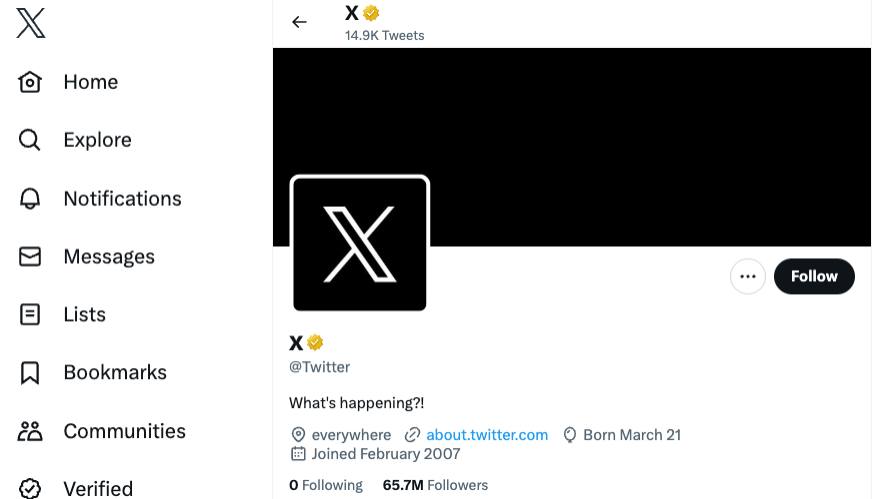Receive free Design updates
We’ll send you a myFT Daily Digest email rounding up the latest Design news every morning.
If you’ve been on the formerly-bird-themed hellsite today, you’ll have noticed something of a rebrand has occurred. Twitter is now X, with Elon Musk reprising the name (and domain) of his old company, X.com, which was ingested into the company that became PayPal about two decades ago.
Musk wants the app to do everything, including banking: a moderately frightening proposition if you live in the US, where transferring money is regarded as some kind of futuristic technology. He re-bought the domain back in 2017, so this could almost be described as a long-term plan. Here’s Twitter X boss Linda Yaccarino, with some adjacent word salad:
X is the future state of unlimited interactivity – centered in audio, video, messaging, payments/banking – creating a global marketplace for ideas, goods, services, and opportunities. Powered by AI, X will connect us all in ways we’re just beginning to imagine.
— Linda Yaccarino (@lindayacc) July 23, 2023
Frankly, the continued adventures of the world’s most divorced man and his enablers aren’t super interesting, but Alphaville was intrigued by some drama prompted by the rebrand over on typography Twitter. Sorry, typography X.
Some typophile Xers concluded that the X, which was kindly donated by one of Musk’s reply guys, is lifted from Monotype’s Special Alphabets 4 font:
Elon Musk’s new logo for Twitter’s re-branding as “X App” is simply the capital X glyph from the font “Special Alphabets 4” from Monotype’s Special Alphabets font family. pic.twitter.com/khKWBZNmBU
— Fontendo (@Fontendou) July 24, 2023
That led some Xers to express some ungenerous views, based on Musk’s occasionally slapdash approach to legal compliance:
Twitter’s new X logo wasn’t made by an in-house designer. It’s from an old podcast hosted by one of the cult that Elon took from his replies.
The font is @Monotype’s Special Alphabets 4. Who wants to bet Musk didn’t pay for the rights before slapping it all over the place? pic.twitter.com/vB33pDIzeb
— Paris Marx (@parismarx) July 24, 2023
Anyway these Xers were wrong because Musk literally tweeted out the X, a standard Unicode glyph, hours earlier.
𝕏
— Elon Musk (@elonmusk) July 24, 2023
Unicode provides an encoding standard for about 150,000 different characters including letters across multiple languages and other symbols. Think of the Unicode standard as a collection of bar codes: a computer reads the code, and then produces the corresponding glyph (or symbol) from whatever font it is presently rendering.
The code for X’s X is U+1D54F, known as Mathematical Double-Struck Capital X — a character intended for use by mathematicians.
Because making 150,000 bespoke symbols for every new font would be insanity, a font file will only contain replacement glyphs for some of these characters. For most fonts intended for use in the West, that’s likely to mean lower and upper case Roman characters, punctuation marks and a smattering of symbols. Any input Unicode character that the font in use doesn’t contain will be rendered from a standard set of Unicode glyphs that all operating systems have. This fallback system is known as cascading.
Twitter, sorry argh, X uses a bespoke font, Chirp. It is missing a lot of Unicode characters, including Mathematical Double-Struck Capital X, so fallbacks are used for these. It is possible that Chirp could be updated to include a custom version of U+1D54F, but given generic fallback version already now the logo so it’s hard to see why they’d bother.
Font rendering on FT.com works similarly — so even though you’re probably reading this in Georgia (the font, not the country or state), we can still insert the ‘Twitter X’ here, because it will render the fallback glyph.
Here you go: 𝕏. Or in bold: 𝕏.
If you somehow run X.com, or FT.com, in a different font that contains a glyph for U+1D54F, you’ll see that instead.
“Hang on though”, you may be thinking, “those Xs and the one in that Musk tweet aren’t the same as the X logo.”
Confused reader, that’s might be because you’re on Windows (or some other esoteric operating system), which has a different set of fallback glyphs, including a different-looking U+1D54F. Compare and contrast:
Anyway, back to the point [ed: there’s a point?!].
Basically, X’s logo isn’t stolen. Phil Garnhan, executive creative director at Monotype, confirmed to Alphaville that there was no clash:
Regarding your question on the Twitter X logo, we can confirm that whilst it is similar, this is not the capital X glyph from Monotype’s “Special Alphabets 4” font.
It will be mildly interesting to discover if the particular Unicode X that X has commandeered can ever become a trademark, given it’s part of such a widely-available glyph set. And we’re not certain who created the glyph itself — presumably it may be Apple, who could, we suppose, still decide to cause a fuss.
So there we go, mystery probably solved. Yes, it’s a slow Monday, whatever could you mean?
Further reading
— The detailed, subjective ranking of research note graphic design you’ve always wanted
Read the full article here



